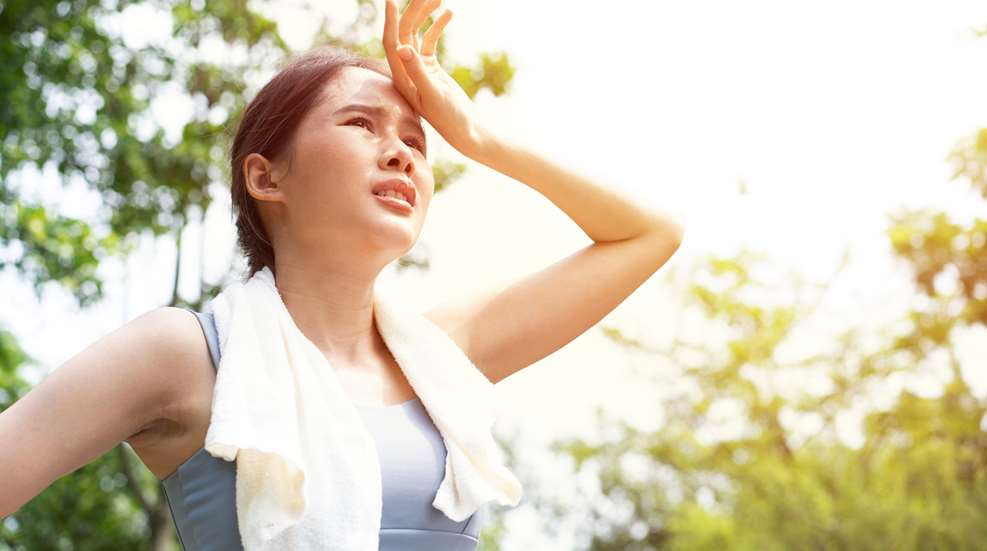
Summertime typically offers the opportunity to spend more time outdoors. But with increased exposure to the sun and the elements, there is also an increased chance of experiencing heat-related illness. Being proactive to avoid a heat-related illness is crucial if you are participating in outdoor activities, particularly those that are strenuous. It it is important to understand how the body reacts to increased temperatures, and equally important to be able identify some common heat-related illnesses—and how to prevent them.
The body has several mechanisms to cool itself, especially when it becomes overheated due to high temperatures or physical exertion. The primary method is sweating. Sweat glands in the skin produce sweat, which evaporates and cools the skin. This evaporation process helps to dissipate heat from the body. Blood vessels near the skin surface dilate or widen, allowing more blood to flow near the skin. Called vasodilation, this enhances heat loss from the body through radiation and convection. Breathing rate may also increase in response to heat, which can help expel some heat from the body through exhaled air.
All these mechanisms work together to maintain a stable core body temperature. Without adequate hydration, regular breaks and finding some shade, these mechanisms can become overwhelmed due to exposure to high temperatures or intense physical activity. It is important to be aware of heat signs and symptoms to prevent these conditions.
Since the body cools itself primarily through evaporating sweat, it is very important to stay hydrated. In hot and humid weather, the sweat does not evaporate. It tends to “puddle.” Sweat that puddles is not cooling. In that case, a person is at greater risk for a heat-related illness, either because of excessive water loss, an increased body temperature, or both. The four most common heat-related illnesses to be aware of are heat syncope, heat cramps, heat exhaustion and heat stroke.

Heat Syncope
Heat syncope is a type of heat-related illness when a person experiences dizziness or fainting. This usually happens when a person is exposed to heat and especially if they are standing for long periods of time, or if they stand up too quickly and feel light-headed in the heat. Other symptoms may be blurred vision, feeling weak and nauseous. Being hot and dehydrated increases the risk for syncope.
Heat syncope is usually triggered by inadequate hydration, which can lead to dehydration. Blood vessels widen in response to heat, which can lead to a decreased blood flow to the brain. This condition can usually be prevented by staying hydrated with water or drinking sports drinks to replace the electrolytes lost during profuse sweating. Taking frequent breaks in shaded areas or in the air conditioning, wearing loose-fitting, lightweight and light-colored clothing, and gradually acclimating to hot conditions can help prevent this from happening.
If you see someone experiencing heat syncope, move them to a cool place. Offer them fluids to drink, allow them to lie down and elevate their legs. Apply cold packs, ice or a damp cool towel to the head and neck area to help cool the body. If symptoms do not improve, seek medical attention. Heat syncope is generally considered less severe as compared to other heat-related illnesses. If left untreated, it can increase to more severe heat-related illnesses.
Heat Cramps
Heat cramps are muscle spasms or contractions that can be quite painful. They are most commonly found in the legs, calves, thighs and sometimes in the abdomen. When these muscles are cramping, they usually feel firm or tight to the touch. They happen during or after strenuous activity in hot weather.
Heat cramps occur when sweating depletes the body’s salt and fluids. This leads to a loss of electrolytes such as potassium, magnesium and sodium. Ultimately, this leads to dehydration. The electrolyte imbalance and dehydration contribute to muscle spasms. Heat cramps can usually be prevented by staying hydrated with water or sports drinks to replenish electrolytes before, during and after activities. It is beneficial to take frequent breaks in a cool or shaded area. Wearing loose-fitted, lightweight clothing and light colors also help to keep cool.
If someone is experiencing heat cramps, allow them to rest in a cool place and offer water or sports drinks that contain electrolytes. Gently stretch and massage the cramping muscles. Placing ice packs or cold towels around the affected muscles can also aid in relief. If symptoms do not improve, seek medical attention. Heat cramps are generally considered less severe compared to other heat-related illnesses. But if left untreated or if the cramps are severe, persistent, or the person is unable to drink water due to nausea or vomiting, it can progress to more severe heat-related illnesses. It is important to address heat cramps promptly to prevent them from worsening or leading to more serious conditions such as heat exhaustion or heat stroke.

Heat Exhaustion
Heat exhaustion occurs when the body overheats due to prolonged exposure to hot temperatures and a lack of fluid intake. It can take place when one has an extreme loss of water through excessive sweating. Although considered less severe than heat stroke, uncontrolled heat exhaustion is an urgent medical situation that can quickly progress if untreated.
Symptoms of heat exhaustion may include heavy sweating, dizziness or a feeling of lightheadedness, weakness, extreme exhaustion, headache, a rapid pulse, nausea or vomiting. Muscle cramps can occur, and the skin may feel cool to the touch and even develop goosebumps, despite the high temperatures. Heat exhaustion can usually be prevented by staying hydrated by drinking plenty of water or sports drinks with electrolyte-containing properties. Strenuous outdoor activities should be avoided, if possible, during the hottest part of the day, which is usually midday to late afternoon. Take frequent breaks, drink lots of fluids, and get into the shade or air conditioning whenever possible.
If someone is showing signs of heat exhaustion, immediately get them out of the heat. Urge them to drink cool water or sports drinks to rehydrate. Fan them and remove any excess clothing and apply cold packs or pour cold water over their body to lower their body temperature. If symptoms do not improve within a short period of time, seek immediate medical attention to prevent progression to heat stroke, which is a much more severe and potentially life-threatening condition.

Heat Stroke
Heat stroke is a true medical emergency and is the most severe form of heat-related illness. It occurs when the body is unable to regulate its temperature and cannot cool itself. Body temperature can rise to critical levels, typically above 104°F. If someone is experiencing heat stroke, it can be life-threatening and requires immediate medical attention. It is critical to cool down the person as quickly as possible, and by any means possible.
Symptoms of heat stroke can include a high body temperature, usually 104°F and above. A person’s skin may look red and flushed, and feel hot and dry, or even clammy to the touch. They may experience a rapid pulse, headache, dizziness and/or confusion, nausea, vomiting, or even a loss of consciousness. Heat stroke can usually be prevented by staying hydrated with water and electrolyte-containing fluids in hot and humid temperatures. Avoiding prolonged exposure to the heat, especially during the hottest part of the day. Always take adequate breaks in the shade or air conditioning to cool down.
If someone is showing signs of heat stroke, immediately move them to a cool and shaded area. Remove their clothing and immerse them in cold water if possible. Position ice packs in the person’s armpits, groin, and around their neck. If the person has lost consciousness, keep their airway open and never give an unconscious person anything by mouth. Prompt recognition and treatment of heat stroke are crucial to prevent serious complications such as organ damage, brain injury, or death.
By following a few preventative measures, you can significantly reduce the risk of heat-related illnesses and stay safe during hot weather conditions. Always stay hydrated by drinking plenty of water and electrolyte-replenishing fluids. Wear lightweight, light-colored, and loose-fitting clothing, which helps your body cool down through evaporation of sweat. Protect yourself from the sun with long sleeves, sunscreen, sunglasses and a wide-brimmed hat. Familiarize yourself with the signs and symptoms of heat-related illnesses and keep an eye on those who are vulnerable to heat such as the youth, elderly, and those with medical conditions. Take frequent breaks in the shade or air conditioning, especially during the heat of the day. Always err on the side of caution and seek medical attention if you or someone else shows signs of increasing heat-related illnesses, which could ultimately lead to heat stroke. The best way to prepare for heat-related illnesses is to take precautions to prevent the illness.














































